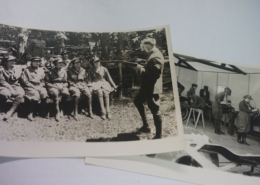Found in the Attic!
While cataloguing boxes of objects stored in the attic, Collections Assistant, Joni Joseph made some interesting finds:
Buttons from 1800!
These three porcelain buttons c. 1800, are hand painted with images of a classical female profile. Our resident Jeweler y expert believes they would have originally on a man’s waistcoat, though they were found in a box of women’s objects. Further research is necessary to find out who they belonged to and how they got to Tudor Place…
The metamorphosis card is much like the current Scanimation craze in children’s books. We assume it is a political collectible since Woodrow Wilson, Theodore Roosevelt, and William Taft ran for the presidency in 1912. Measurements: L – 12.5 cm, W – 7.6 cm; not terribly large – about the size of a postcard. The lined transparency was probably attached to a tab of some sort that extended through the half-moon cutout allowing the viewer to move it back and forth. This portion is missing. The lines really need to be in the correct spot to reveal the changing images.






